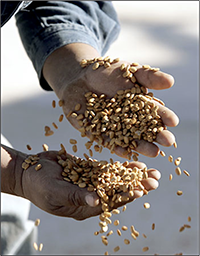Food in the Canada – EU Comprehensive Economic Trade Agreement in Principle (CETA)
A briefing prepared by Stuart Clark (Canadian Foodgrains Bank) with help from Sophia Murphy (Institute for Agriculture and Trade Policy) – Nov 2013

Agriculture in CETA
Negotiations for a trade and investment treaty between Canada and the European Union began in 2009. Progress on the treaty was very slow until last year when both parties decided for their own reasons that the treaty would serve their interests. The draft treaty’s provisions are wide-ranging including the opening of the Canadian services market (banking, insurance, etc.) and the establishment of European companies’ right to sue for damages if new Canadian environmental or health laws or regulations reduce their profits. Agriculture is a small but important part of the agreement and is linked to many other aspects of the agreement.
In the case of Canada, there were important lobbying efforts supporting the completion of negotiations by some Canadian farm groups, particularly the western Canada-based Canadian Cattlemen’s Association (see below). Conversely, some farm groups, notably those in the supply-managed sectors (dairy, eggs, poultry), were very worried that any new treaty would undermine the predictability of their Canadian market, a key element of this very successful marketing system.
The complete text of the recently announced agreement in principle is still not available. However, the government has released some technical details. This brief is based on this and other available information.
Supply Management Impacts

(Photo credit: Flickr)
Despite its strong support for trade liberalization, the Canadian government has continued to declare its commitment to protect Canada’s supply managed farm sectors. This is understandable given the strong presence of dairy, egg and poultry farmers in the politically important provinces of British Columbia, Ontario and Quebec.
The concessions given under CETA reflect these commitments. Canadian eggs and poultry markets, which were of little interest to European farmers, were excluded entirely from the agreement. Dairy, and particularly cheese, the highest value part of the dairy market, was of much greater interest. This was the area where Canada made significant concessions.
Currently Canada allows about 21,000 tonnes of foreign cheese into the Canadian market (about 5% of the total). Under the CETA, Europe would be allowed to export an additional 18,500 tonnes of cheese to Canada, raising imports to 9% of total cheese consumption. This is a very substantial increase and will certainly be felt by both Canadian cheese producers and the dairy farmers that supply them. Canadian expensive fine cheeses are expected to be most affected but it is not clear whether or not the new European imports will expand the Canadian market or simply replace Canadian producers or both. The substantial investment by small specialty cheese producers is certainly threatened. It is important to note that Canada’s supply management system depends upon certainty for our dairy, poultry and egg producers. Any trade policies that reduce that certainty undermine this system. CETA concessions may provide further openings for undermining this system in future agreements (e.g. Trans-Pacific Partnership – TPP).
Beef and Hormones

The Canadian Cattlemen’s Association was one of the strongest agricultural supporters of CETA. The Canadian beef industry (farmers and processors) have had very little practical access to the highly protected European beef market. The total imports of beef from all sources into the European market are much less than 1% of Europe’s total consumption (8 million tonnes per year). Import duties that run as high as 140%. Europeans also rejected beef treated with growth hormones and other growth promoters (which are commonly used by Canadian producers). There was little incentive to Canadian beef producers to reach this market up until now.
As a result of the CETA, Canada’s duty-free access to the EU market will rise from 3,200 tonnes of beef to 37,500 tonnes, a substantial increase. However, Europe will continue to enforce its directive against the use of growth promoters (hormones and beta-agonists) and require changes in Canadian slaughtering. The expectation of some analysts is that the creation of a European export market will create the necessary incentive for many producers to stop using these chemicals. Along with the move by some Canadian fast food outlets to offer hormone-free beef, this should be seen by consumer and health groups as a positive move.
GM Crops

There is no provision that specifically allows for trade in GM food crops. The EU and Canada maintain zero tolerance for the imports of GM foods that have not been approved by respective domestic regulatory agencies. While GM food crops are not included in CETA provisions, the Canadian biotech and pesticide industry group, CropLife Canada, has celebrated the agreement. Concretely, aside from the expanded export opportunities for Canadian grains and oilseeds in general, they have seen one gain. According to CropLife Canada, CETA establishes a biotechnology working group in order to shorten the timelines for the approval of genetically modified crops for cultivation in the EU, to strengthen ‘science-based’ regulation and to revise the ‘low-level presence’ policy for non-GMO imported commodities.
While there appears little gained by the Canadian biotechnology industry, CETA could maintain pro-GMO pressure on the EU regulatory process. Labelling of GMO foods and food ingredients in the EU and consumer resistance to GMOs will likely continue to keep these products out of the EU food system. Canadian GM soybeans are already widely used as animal feed in the EU.
Government Procurement

Government procurement, especially local procurement for schools and other public institutions, is seen by farmers as an important alternative marketing channel, opening possibilities outside the dominant centralized supply chains controlled by supermarkets. In general, the purpose of CETA (and other recent bilateral trade agreements) is to give ‘the other side’ the right to bid to provide any goods or services purchased by governments. For the first time, such market access provisions are to be applied to all levels of government, including universities, prisons, schools and hospitals. In principle, this could be a threat to municipal or provincial government or academic institutions’ local procurement of food or food services.
However, according to the Technical Summary provided by the federal government, the CETA contains some limitations:
- Government procurement only applies to contracts worth more than $315,000 (provincial, municipal, universities, school boards and hospitals) and $205,000 (federal government).
- It specifically excludes all procurement of agricultural goods for ‘food programs’. It is not clear what this covers.
- It excludes public/private concessions for the provision of services. This could apply to food services and catering catering.
- It excludes regional economic development programs in several provinces and all the territories unless paid for by the federal government. Federal funding is common, particularly in the territories.
In short, the CETA doesn’t appear to eliminate the possibility of using smaller government procurement contracts to develop local food systems but it does severely limit the potential for some larger projects.
Comments on this brief should be directed to Abra Brynne - abra@foodsecurecanada.org.
- Log in to post comments

